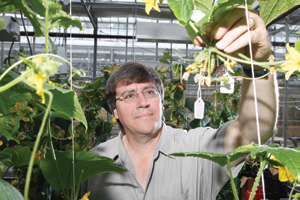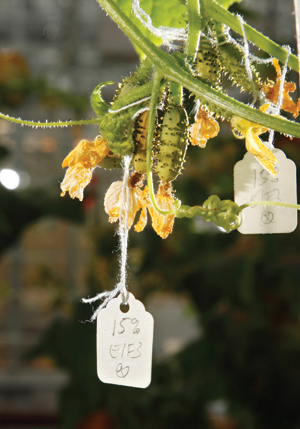
Outbreaks of Fusarium – a new and rapidly spreading fungal root disease
– in the Canadian greenhouse cucumber industry has the potential to
cause millions of dollars in losses annually.
Early detection and new germplasm are keys to preventing losses to this emerging disease
 |
| Prof. Barry Micallef takes a closer look. photo by kyle rodriguez, artifacts for life |
Outbreaks of Fusarium – a new and rapidly spreading fungal root disease – in the Canadian greenhouse cucumber industry has the potential to cause millions of dollars in losses annually. Now, a new approach to combatting Fusarium combines cucumber germplasm that’s tolerant to the disease with early detection methods in the hopes of limiting the disease’s destruction.
This dual-action approach was developed by Prof. Barry Micallef, Department of Plant Agriculture, University of Guelph, and his research team to help mitigate the losses a Fusarium outbreak can cause growers.
“Early detection and plant tolerance substantially improve the odds of eliminating the disease, which in turn can improve the success of a growers’ operation,” says Micallef.
OUTBREAKS CAN RESULT IN SIGNIFICANT LOSSES
■ Fusarium was first encountered in Canadian greenhouses in 2000. Without early surveillance mechanisms, it can take two to three weeks to detect the pathogen, by witnessing wilting stems and leaves. But by that time, the entire crop can be compromised. In 2000, outbreaks resulted in a loss of between 20 to 30 per cent of the Ontario crop.
The first way the research team took aim at Fusarium was through the discovery of germplasm – which contains the collective genetics of a plant – that is tolerant to the fungus and its toxin. This germplasm was discovered using advanced testing techniques that can screen a high number of cucumber embryos to test their ability to resist the disease.
This screening process produced germplasm that was found to be resistant and could then be exchanged for susceptible cultivars that are currently being grown.
The second part of Micallef’s research project involved developing new and improved detection methods for Fusarium. Fusarium is a root disease, so the possibility of an epidemic is high, as every plant is connected through the recirculation of hydroponic solution.
Micallef and his research team found that by using high-resolution methods, stem and leaf extension could be closely monitored. By using these methods, they could detect a Fusarium outbreak within six hours of exposing the plant to the pathogen.
 |
| A Fusariumresistant cucumber plant; photo by kyle rodriguez, artifacts for life |
EARLY DETECTION IMPROVES
DISEASE CONTROL SUCCESS
■ Being able to detect an outbreak at the earliest possible point allows growers to apply chemical treatments only when the pathogen is present. This
saves money, eases environmental concerns, and reduces the amount of pesticides to which the cucumbers are exposed.
Imaging devices have shown to be a great early detection mechanism in laboratory trials. However, the cameras are not as practical in a greenhouse setting, because they’re expensive. More work is being done by the research team to develop a more economical imaging device that can give growers the opportunity to respond rapidly to new outbreaks.
Meanwhile, the research team will be working with the Ontario Greenhouse Vegetable Growers on having the tolerant germplasm widely available to seed distributors and breeding companies.
“Being able to detect Fusarium at an early stage will allow for chemical treatment of the disease to occur only when necessary, limiting the amount of chemicals applied to greenhouse cucumbers,” says Micallef.
Also involved in this research is Prof. Bernie Grodzinski, Department of Plant Agriculture, and graduate student Renuka Subasinghe.
This research was funded by the Ontario Greenhouse Vegetable Growers and the Ontario Ministry of Agriculture, Food and Rural Affairs. ■
Kaitlyn Little is a writer with the SPARK (Students Promoting Awareness of Research Knowledge) program at the University of Guelph.
Print this page